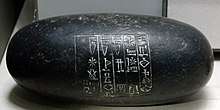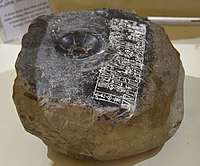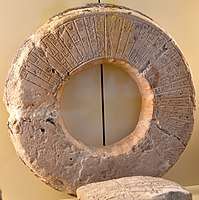Shu-Sin
Shu-Sin, also Šu-Suen (Akkadian: 𒀭𒋗𒀭𒂗𒍪: DŠuDSîn, after the Moon God Sîn", the "𒀭" being a silent honorific for "Divine", formerly read Gimil-Sin) was king of Sumer and Akkad, and was the penultimate king of the Ur III dynasty. He succeeded his brother Amar-Sin, and reigned c. 1972-1964 BC (short chronology).
| Shu-Sin 𒀭𒋗𒀭𒂗𒍪 | |
|---|---|
| |
 | |
| King of the Neo-Sumerian Empire | |
| Reign | c. 2037 BC – 2029 BC |
| Predecessor | Amar-Sin |
| Successor | Ibbi-Sin |
| Issue | Ibbi-Sin |
| Dynasty | 3rd Dynasty of Ur |
| Father | Shulgi |
Reign
Following an open revolt of his Amorite subjects, he directed the construction of a fortified wall between the Euphrates and the Tigris rivers in his fourth year, intending it to hold off any further Amorite attacks. He was succeeded by his son Ibbi-Sin.
The oldest love poem ever found is addressed to Shu-Sin by a female speaker.[1] It includes erotic language, and the speaker expresses her strong desires and longings for the king.[2][3][4]
Year names of Shu-sin
The year names for the reign of Shu-sin are all known and give an information about the events of his reign. The most important ones are:[5]
1 Year Szu-Sin became king
2 Year Szu-Sin the king of Ur made / caulked the boat of Enki (called the) 'ibex of the abzu'
3 Year Szu-Sin the king of Ur destroyed Simanum
4 Year Szu-Sin the king of Ur built the amurru wall (called) 'muriq-tidnim / holding back the Tidanum'
6 Year Szu-Sin the king of Ur erected a magnificent stele for Enlil and Ninlil
7 Year Szu-Sin, the king of Ur, king of the four quarters, destroyed the land of Zabszali
9 Year Szu-Sin the king of Ur built the temple of Szara in Umma
Artifacts
There is vast number of artifacts with inscriptions in the name of Shu-sin.[6]
 Door socket inscribed with the name of Shu-Sin, king of Ur, Ur III. From Mesopotamia, Erbil Civilization Museum.
Door socket inscribed with the name of Shu-Sin, king of Ur, Ur III. From Mesopotamia, Erbil Civilization Museum..jpg) Inscription with the name of Shu-Sin
Inscription with the name of Shu-Sin.jpg) Seal of Shu-Sin: "Shu-sin, the Great King, King of Ur, King of the four world quarters..."
Seal of Shu-Sin: "Shu-sin, the Great King, King of Ur, King of the four world quarters..." Inscribed stone ring of a fountain, in the name of king Shu-Sin. Pergamon Museum.
Inscribed stone ring of a fountain, in the name of king Shu-Sin. Pergamon Museum.
See also
- A Love Song of Shu-Sin (B)
- History of Sumer
- Sumerian king list
References
- "Oldest love poem". Guinness World Records. Retrieved 2019-07-18.
- Fant, Clyde E.; Reddish, Mitchell G. (2008-10-15). Lost Treasures of the Bible: Understanding the Bible Through Archaeological Artifacts in World Museums. Wm. B. Eerdmans Publishing. ISBN 9780802828811.
- Longman, Tremper III; Enns, Peter (2008-06-06). Dictionary of the Old Testament: Wisdom, Poetry & Writings: A Compendium of Contemporary Biblical Scholarship. InterVarsity Press.
- "The World's Oldest Love Poem". Ancient History Encyclopedia. Retrieved 2019-07-18.
- "T6K4.htm". cdli.ucla.edu.
- "CDLI-Found Texts". cdli.ucla.edu.
- Nicole Brisch, The Priestess and the King: The Divine Kingship of Šū-Sîn of Ur, Journal of the American Oriental Society, vol. 126, no. 2, pp. 161–176, (Apr. - Jun., 2006)
- Stiebing Jr., William H. (2003). Ancient Near Eastern History and Culture. New York: Pearson Education. ISBN 0-321-06674-X.
External links
| Wikiquote has quotations related to: Shu-Sin |
| Wikimedia Commons has media related to Shu-Sin. |
| Regnal titles | ||
|---|---|---|
| Preceded by Amar-Sin |
King of Ur, Sumer and Akkad ca. 21st century BCE |
Succeeded by Ibbi-Sin |